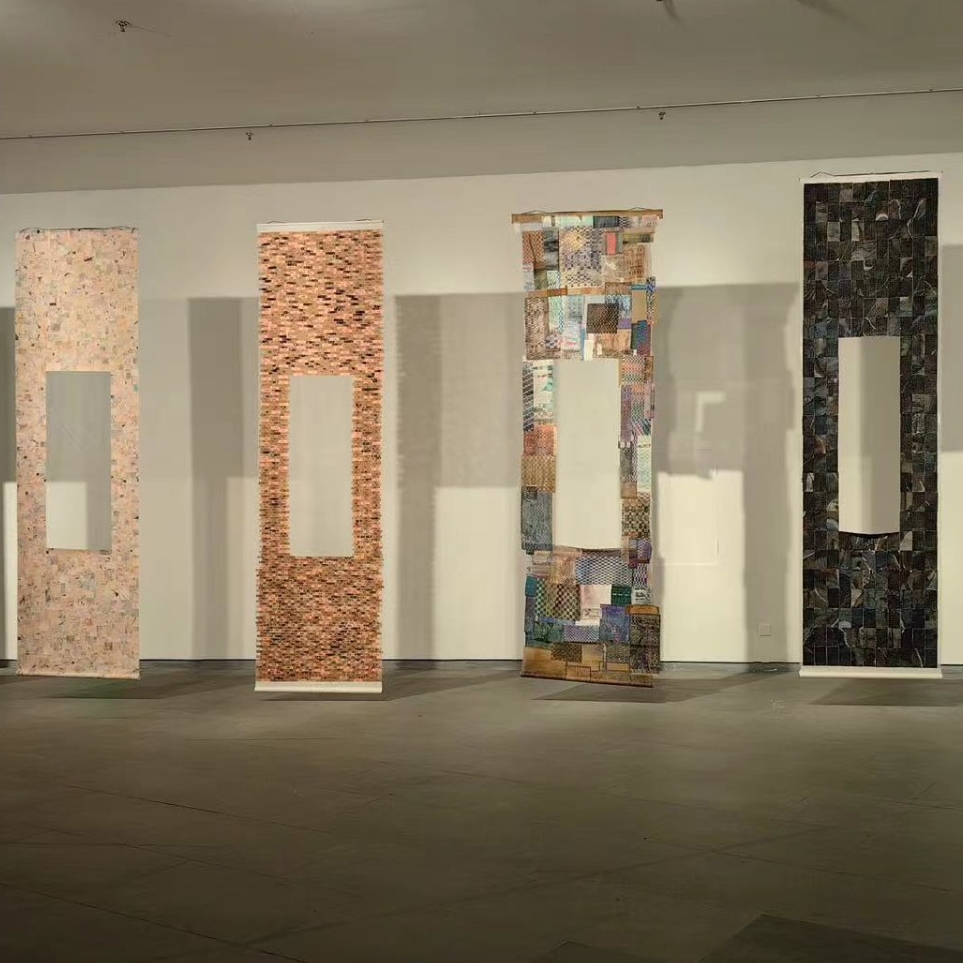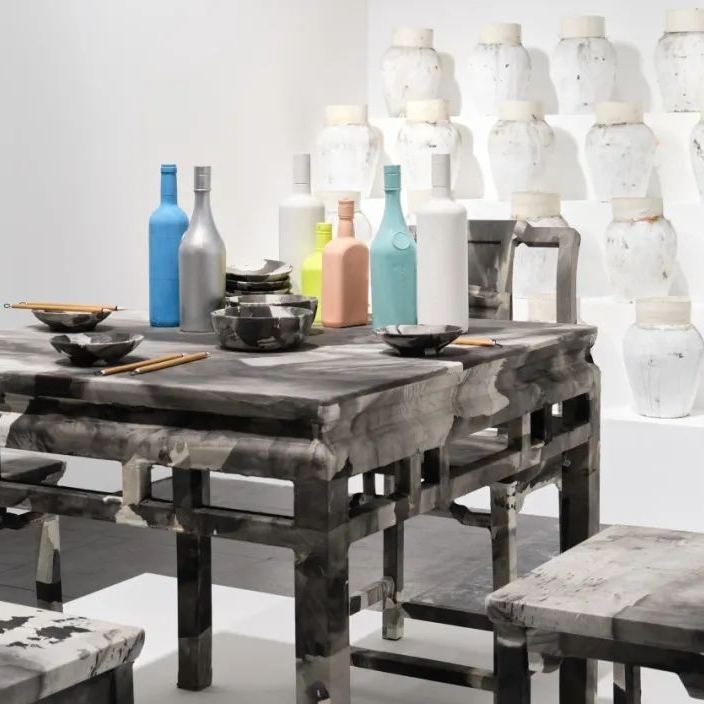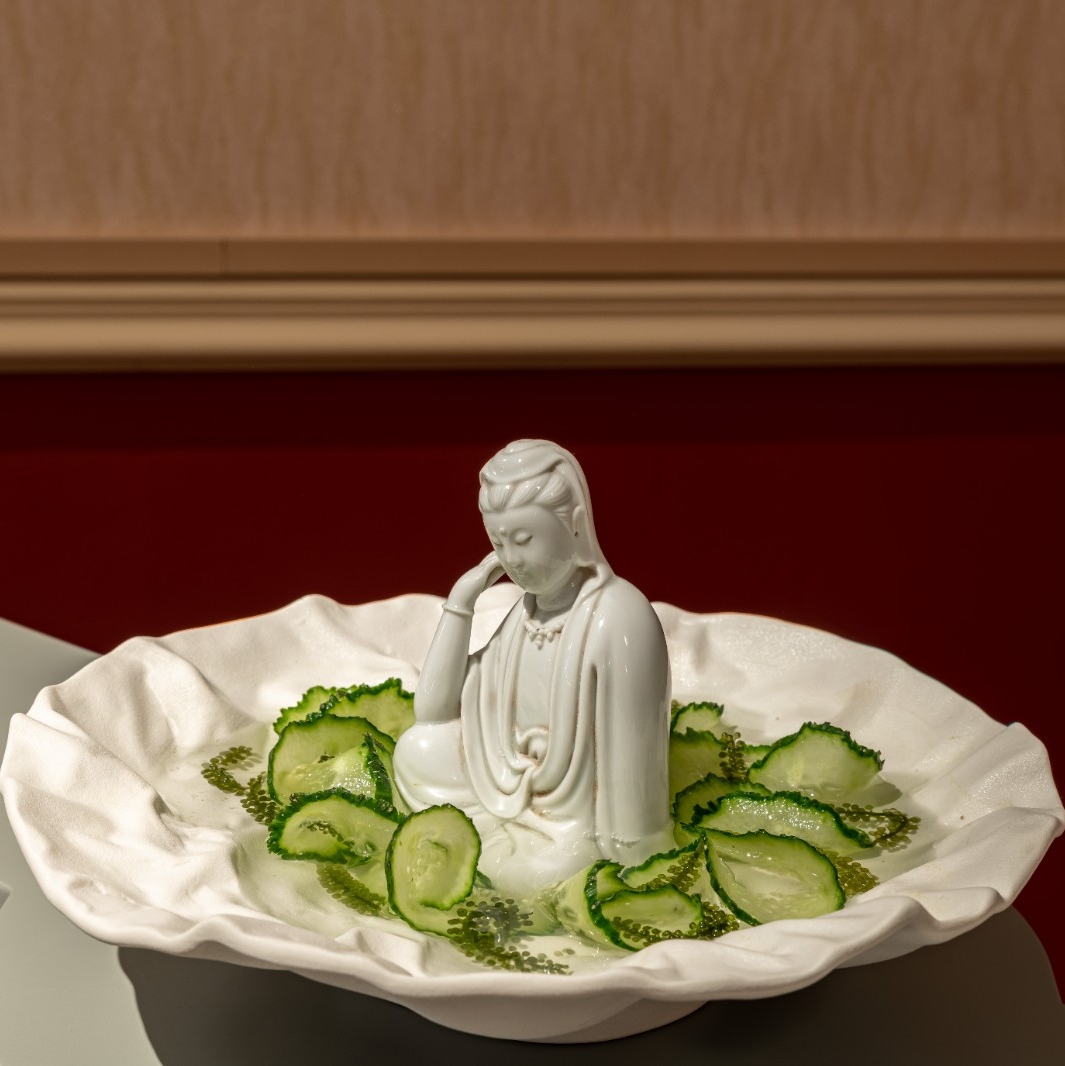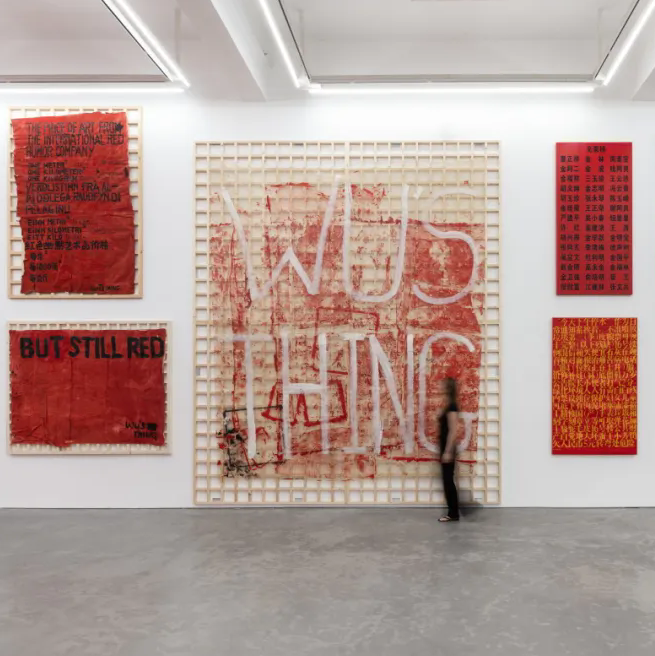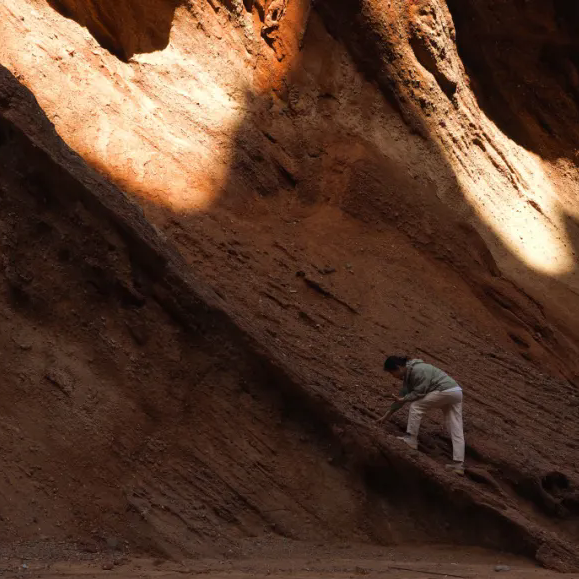
On 7th November, 2021, due to the requirements of pandemic prevention and control, “Super Fusion: 2021 Chengdu Biennale” quietly opened to the public. As one of the largest scale art biennales with an incomparable academic level in the post-pandemic era, the 2021 Chengdu Biennale explores 272 artists/groups and their creations both at home and aboard. Eight themed exhibitions are developed to elaborate the main theme “Super Fusion” this year, namely, “Polymorphic Co-Existence”, “Urban Co-Habitation”, “Technological Co-Respondence”, “Zeitgeist Co-Evolution”, “Ecological Co-Development”, “Craft Co-Operation”, “Ethnic Co-Creation”, “Artistic Co-Inspiration”, which work together with an international conference of gallery directors to form the international pattern of the 2021 Chengdu Biennale. Besides, 17 parallel exhibitions located around the whole city also facilitate its macroscopic imagination.
The Chief Curator Fan Di’an, who serves as the Chairman of China Artists Association and the President of China Central Academy of Fine Arts, stated in the Preface of “Super Fusion”: “The world has entered a new era in which previous orders and systems no longer hold, and great changes are taking place in the fields of politics, economics, culture and ecology. The fate of people has never been so intimately interconnected. The age in which we live calls for greater dialogue and co-operation between us all, a new system of cultural values that inspires hope.”1 Because of the pandemic, numbers of international art and cultural events are either postponed or cancelled. Under this circumstances, the scheduled opening of the 2021 Chengdu Biennale is undoubtedly given a special historical meaning. The specificity, however, not only refers to its scale and lineup, but it starts with the notion of “Garden City” to explore the humanism, ecosystem and sustainable development through the model of a biennale. Meanwhile, it is also notable that the 17 parallel exhibitions based on the local cultural field of Chengdu explore the close-knit symbiosis of art, culture and lifestyle in this city.



Exhibition View of “Super Fusion: 2021 Chengdu Biennale”
2001-2021: The Twenty-year Journey of the Chengdu Biennale
The first Chengdu Biennale can be traced back to the beginning of the 20th century. In 1992, “The First 1990s Biennale Art Fair, Guangzhou, China: Oil Painting Section” organized by Lv Peng in Guangzhou is regarded as a sign of the opening of the Chinese contemporary art market. Since then, biennales supported by the local government such as Guangzhou Biennale and Shanghai Biennale gradually flourished during the new century in China. At the same time, a biennale founded by a private capital company was born in southwest China, namely, the first Chengdu Biennale held in 2001. A year before, the third Shanghai Biennale entitled “Spirit of Shanghai” focused on cultural openness, inclusivity, hybridity and radical attitudes of innovation which are used to define the “Shanghai Spirit.” In this biennale, for the first time, a Chinese biennale invited international curators to join the curatorial team, which marks the very beginning of the internationalization of the biennale in China.
Compared to the third Shanghai Biennale, the theme of the first Chengdu Biennale, “Yangban Easel Art in China”(CN.样板·架上) seemed to be limited. However, the members of the exhibition committee precisely proposed to reexamine the “Jiashang art” ( a term from Russian,Станковое искуство) 2 in China based on the criticisms of the third Shanghai Biennale in terms of “instead of copying the model of the western biennales, (we) should make some effort to promote the national culture and art” 3, and the reflections such as “whether China has established its own contemporary standard currently” 4. In accordance with these thoughts, “Jiashang art” has been developed as the standard of selecting works for the first Chengdu Biennale. However, with the emphasis on “the openness of Jiashang art” as addressed by the organizer, active and diverse artistic expressions could be featured in this biennale.

Qiu Zhijie's work was at the 1st Chengdu Biennale in 2001.
Image Source: View Note 3 for Details.
Before the fifth Chengdu Biennale held in 2011, the earlier four biennales were all supported by the private capital. Therefore, the capital source, mode of operation and other practical questions have directly impacted on the themes and exhibition model over the ten years. The second Chengdu Biennale “Landscape: Century and Heaven” abandoned the topics within the “elite art” field, instead, it turned to focus on the pop culture and human landscape, which presented a totally different path with Shanghai Biennale, Guangzhou Biennale and Beijing Biennale of the same period. However, due to its close relationship with the local estate company and the scenic area, criticisms regarding commercialization and vulgarity were foreseeable.
The following third Chengdu Biennale was entitled “Reboot”, which lean an eye to the guohua (Chinese painting) and ink art cultivated from the Chinese tradition. In addition, inviting international scholars to join the curatorial team has introduced a multi-dimensional perspective. After the Wenchuan earthquake of 2008, a context was established or a trend, of “grand narrative” around the whole country. In this case, the fourth Chengdu Biennale took “China Narratives” as the theme, showcasing the “common concerns” of the whole nation and the times. Obviously, the curatorial team did not intend to copy the model of the National Fine Arts Exhibition, instead, they announced “a grand narrative of people’s ethics” rather than “an individual narrative of free ethics” 5.

Exhibition View of “China Narratives: The Fourth Chengdu Biennale”
Image Source: View Note 5 for Details.
In 2011, under the background of constructing the “Modern Garden City”, the fifth Chengdu Biennale was finally taken over by the local government. With the theme “Changing Vistas: Creative Duration”, this biennale developed the International Design Exhibition and International Architecture Exhibition more than the Contemporary Art Exhibition. As this biennale focused on the city itself once again, together with multiple perspectives beyond the pure fine arts, as well as the government’s huge support, the grand occasion in terms of public engagement this year had surpassed anytime hereto foreseen.
After ten years, the Chengdu Biennale has eventually realized the transformation from private-funding support to government support, which seemed to indicate its stability and systematization. However, it cannot be ignored that due to such a transformation regarding the nature of the Chengdu Biennale, a long-term breaking-in period was necessary at the very beginning. Hence, in the following Chengdu Biennale held in 2016, the conflicts between the new curatorial team introduced by the government and the traditional team, and the challenges brought up by the conflicts precisely demonstrated the necessity for the run-in period.
When the “Super Fusion: 2021 Chengdu Biennale” launched with an incomparable scale and dimension, the twenty-year journey of Chengdu Biennale showed its tough exploration during these years. From the theme and operation model every year, the contradictions and compromise can be observed—they wandered between “elite” and “popular”, “academic” and “commercial”. Many issues discussed in the past few years are still hot topics within the art field, such as the contemporary transformation of traditional guohua and ink art, pop culture and urban landscapes, etc.. It rolls forward in a cyclical mode, with some problems solved, some patterns retained, and undoubtedly brings a new space for thinking continuously.

 Exhibition View of “Changing Vistas: Creative Duration—Chengdu Biennale”
Exhibition View of “Changing Vistas: Creative Duration—Chengdu Biennale”
Image Source: View Note 5 for Details.
Cut-in and Provoking: The Southwestern Artistic Group in China and Chengdu
Compared with other different exhibition formats, one of the characteristics of the biennale is to focus on the “present”, that is, “here and now” where the cultural event takes place, and their effect of the “spectacular of the everyday.” Besides, because of their site-specificity, cultural events may refer back to, produce or frame the history of the site and communities' collective memory. 6 In this case, a continuous city biennale is an excellent way to observe the appearance of local art groups, the memory and development of city civilization.
“Urban Humanities: Art Cluster in the Southwest”, as one of the parallel exhibitions in the 2021 Chengdu Biennale, sorts out the art clusters in Chengdu, Chongqing, Guiyang and Kunming, outlining the history and current situation of southwestern art clusters through case studies. “The form of art cluster is not what’s important, but it is the cultural spirit of the art cluster that counts.” In the Preface of the exhibition, curator Lan Qingwei retrospected the birth, collapse and regeneration of art clusters as a means of artistic creation from the “'85 New Wave” in the 1980s to the 1990s and then to the new century.


Exhibition View of “Urban Humanities: Art Cluster in the Southwest”
Image Source: Blue Roof Art Museum
As the 798 art district in Beijing and M50 art district in Shanghai appeared in the new millennium, the Blue Roof art district represents the typical art community based on studios formed spontaneously by artists in Chengdu. In recent years, with the opening of art museums and public art spaces in the region and the improvement of related auxiliary facilities, the Blue Roof art district has gradually developed into a comprehensive art community that integrates creation, research and life, representing the appearance and spirit of the Southwestern artist cluster. Moreover, it is embedded in the construction and development of Chengdu’s urban culture in an active and positive state.
The active and special state of southwestern art groups can be seen as early as the “Scar art” in the late 1970s and the “‘85 New Wave” in the middle of the 1980s. In the late 1970s, in southwest China, the representative artists of “Scar art”, such as Luo Zhongli, Chen Conglin, He Duoling, Gao Xiaohua, among others, emphasized a nuanced observation and experience of life, rather than the mainstream idealism and heroism of the times. In their creation, the delicate depiction and expression of ordinary people's fate and emotions were typical. Later, the “New Figurative Painting Exhibition” in 1985 introduced Mao Xuhui, Zhang Xiaogang, etc, who were the representative artists of the “New Figurative Art Group”. They were deeply influenced by numerous modern western novels and philosophies, therefore, their works showed a strong sense of expressionism and portrayed the complex emotions of life, the alienation of people in the environment and society, etc..

Group Photo of Some Artists of “New Figurative Painting Exhibition” in 1985
Image Source: http://www.art-ba-ba.com/
Located in the southwest hinterland which is away from the mainstream, the geographical gathering allows the southwestern art cluster to keep its independence and gradually form a stable and distinct pattern in the field of Chinese contemporary art. Specifically, Chengdu, as a primary city for the southwestern art cluster to live and work, the city nature, culture, and customs brought by its geography, climate, dietary habits, and lifestyle, have shaped the appearance and features of the local artists’ creation—on the one hand, the artists are adept in capturing the life details and delicate feelings; on the other hand, their avant-guard attempts and experiments in art can be tolerated by the residents to a great extent. In addition, poetry, literature, theater and drama and other types of cultural forms are also activated in Chengdu. In the recent ten years, with the development of public museums, private art museums, and theaters, art is gradually becoming a part of people’s everyday life. The large-scale comprehensive art communities, such as the Luxelakes which integrates the art museum, theater, eco-park, among others, dramatically promotes the mutual fusion between different types of art and life in the city.
Just as the journey of the Chengdu Biennale from being private-funded to government-supported, with the local government’s great investment in the cultural industry, the attitude of art as a lifestyle, has spread from a few art clusters to the lives of citizens. However, it is also interesting to notice that, the active energy of the internal culture and its high resonance with daily life seem to be rich enough to meet the needs of local people, as well as form a rather stable internal circle. This makes the local art community and the residents show less enthusiasm and productivity in terms of exploring external culture, art and thoughts.
It is within this situation that the 2021 Chengdu Biennale has cut in this stable internal circle with a strong artistic volume and lineup. As Lv Peng, the director of the academic committee of this biennale, mentioned in the interview with CAFA ART INFO, “the city of Chengdu and its citizens show a calmness to the external culture, which is the unique character and mentality of this city. But from the perspective of art ecology, the rich artistic outlook of both domestic and international contemporary artists brought by this biennale is a sort of intervention and provocation to the art community in Chengdu. It is significant to the opening and further development of the local artists, as well as the local art and culture.”7





Exhibition View of "Super Fusion—2021 Chengdu Biennale"
Super Fusion: Let Chengdu Embrace Something New
In fact, the unprecedented scale of the 2021 Chengdu Biennale is also a positive “stimulation” for the general public in Chengdu. It brings far more than works of art from other countries and cultures, as well as more perspectives of viewing the world and experiencing life and love, which is especially valuable in the post-pandemic era. From the diverse art events around the whole city, the 2021 Chengdu Biennale presents an intention to liberate the biennale from the formal exhibition space to the public sphere. However, how the audience should view, discover and respond to such an artistic feast may be another challenge for the public, the artists and the curators.


The Exterior View and Models of Chengdu Tianfu Art Museum and Chengdu Museum of Contemporary Art
An afternoon is too rushed for roughly browsing the two art museums located in the Tianfu Art Park covering an area of more than 3,000 acres. Not to mention if one would like to view the eight themed exhibitions presented in the museums carefully. In the first section entitled "Symbiosis of Polymorphism", 39 well-known artists from 12 countries gathered here, using the latest creations and thoughts born in different cultural contexts to explain how the rich artistic styles could co-exist nowadays. For the first time, international artists such as Olafur Eliasson, Anish Kapoor, Leandro Erlich, Katharina Grosse, and Do Ho Suh, have entered the vision of Chengdu. In these times when the destiny of mankind is becoming increasingly close-connected, these artists in the first exhibition chapter explore the issues during the globalization process through their unique and powerful artistic expressions.
While the chapter “Zeitgeist Co-Evolution” emphasizes the cultural industry, commercial art, and pop art activated in this era by starting from the notion of the integration of art, fashion, and design. It goes deep into the commercial society, material culture, and even daily life that human beings dramatically rely on nowadays, presenting an unignorable pattern in the contemporary cultural landscape.



Exhibition View of "Super Fusion—2021 Chengdu Biennale"
Through the eight chapters under the main theme “Super Fusion” this year, the turbulent global landscape, eco-civilization, cultural relationship, the development of technology, art education, among others, are included. The discussion between artists with various cultural backgrounds shows the world with multiple cultures cut into the artistic ecosystem of Chengdu; while the parallel exhibitions are organized based on the nature of Chengdu and art communities here, presenting Chengdu as a city to gradually step into the vision of the world. In this case, the intention of “Super Fusion” may not require every audience to understand the huge amounts of information produced in the process of the rapid development of the world and the times. Instead, it tends to provide new perspectives and thoughts to the public in this city and allows each of them to grab what they need.
At present, viewing the 2021 Chengdu Biennale still needs to follow strict pandemic prevention and control policies. It may be a good chance for us to review the history and development of the city and the biennale, and reflect whether the issues proposed at the intersection of the 20th century and the 21st century have been solved or not. For instance, with the biennale as an opportunity, have we found a contemporary scale that can support an equal dialogue? As an imported product from the West, has the biennale produced local experiences that can be used for reference in the process of continuous practice? How should the artworks in the biennale and the knowledge production behind them have a real relationship with the city, region, and residents where they are located?






Exhibition View of "Super Fusion—2021 Chengdu Biennale"
The retrospect, however, does not mean that the biennale should be confined to history and tradition. Instead, it profoundly participates in and shapes the contemporary biennales which feature “the present”. Undoubtedly, from its first appearance to its blooming everywhere nowadays, the preparation and operation of the biennale in China have matured day by day. Based on different urban cultural fields, biennales in each city present various strategies and temperaments.
Nevertheless, if a biennale is expected to become the cultural name card of a city, to witness and participate in the construction and development of urban culture, it is bound to require a continuous “presence”. On the one hand, this continuity requires a long-term academic summarization and system to form visible urban cultural archives and collections; on the other hand, it is also expected to step out of the boundary formed by elite art and bring art into the urban public sphere and daily life in a more universal form. While the constantly updated strategies adapt to the rapid development of city culture is necessary as well.
The tolerance and openness shown by Chengdu's unique historical genes and cultural character provide an excellent experimental field for the mutual balance of these two aspects. Over the past two decades, the Chengdu Biennale has gradually explored its own path. With the grand restart brought by the “Super Fusion” this year, its continued presence in the future is worth the wait.
It is reported that “Super Fusion—2021 Chengdu Biennale“ remains on view till April 6th, 2022. “Future Co-Conception”, the international conference of gallery directors, will be held during the exhibition.
Text by Emily Weimeng Zhou, edited by Sue/CAFA ART INFO
Photo by Juri Liu, Ximan Guo ©️CAFA ART INFO, Lv Peng
Courtesy of the Organizer.
Notes:
1. Fan Di’an, the Preface of “Super Fusion: 2021 Chengdu Biennale”.
2. In the Chinese theme of the first Chengdu Biennale, beside the word “Yangban Model”(CN.样板), the other keyword is “Jiashang art”(CN.架上). Chinese Critic Liu Xiaochun has defined the meaning of “Jiashang art” in the catalogue of the first Chengdu Biennale in 2001. He mentioned that “Without any equal meaning in English, the term Jiashang art was a definition originally created by Chinese art critics in light of the meaning of ‘easel painting’…As the term in Chinese contemporary culture, ‘Jiashang art’ is actually a misunderstanding of easel painting from the early beginning. ‘Jiashang art’ took the concept of the easel painting, but failed to denote its technical meaning underneath…since none of easel art, standing art or framed art can completely give a voice to the term, we have to transliterate it into ‘Jiashang art’ in this album of paintings.”
The full text can be viewed in the catalogue of Chengdu Biennale 2001, Sichuan Fine Arts Publishing House, 2001, P7.
3. Zhang Yinchuan, The Conversation with Mr. Deng Hong—The First Chengdu Biennale, Art & Life, 2002.
4. Liu Xiaochun, “The State of From Underground to Foreign Countries” Should Be Changed—The Value of Shanghai Biennale,Shanghai: Art China, 2018.
5. Jia Fangzhou, Zou Yuejin, The 4th Chengdu Biennale, Chengdu: The Great Art, 2010.
6. Federica Martini and Vittoria Martini, Just Another Exhibition: Histories and Politics of Biennials, Postmedia Books, 2011.
7. Edited according to the Interview between Lv Peng and CAFA ART INFO.
Reference:
1.Exhibition Text of “Super Fusion: 2021 Chengdu Biennale”.
2. Deng Hong, Liu Xiaochun, The First Chengdu Biennale, Sichuan Fine Arts Publishing House, 2001.
3. Feng Boyi, Thoughts on Curating the Second Chengdu Biennale, Contemporary Art News, 2005. Available from https://news.artron.net/20050914/n6373.html
4. Feng Bin, Shen Kuiyi, Reboot—The Third Chengdu Biennale, Hebei Fine Arts Publishing House, 2007.
5. Changing Vistas: Creative Duration—2011 Chengdu Biennale, Sichuan Fine Arts Publishing House, 2011.
6. Lv Peng, From the Geographical Perspective—Interview with Lv Peng, Contemporary Artists,2019.
7. Ruan Jingjing, The Review of Chengdu Biennale, Art China, 2013. Available from http://art.china.cn/huodong/2013-07/31/content_6169444.htm


